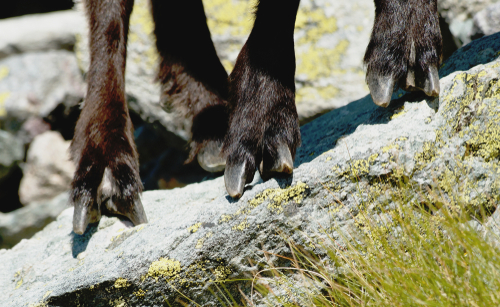

Have you seen your goat limping? While it is not the cause of all limping and soreness, foot rot in goats should be suspected.
All hoofed animals risk foot rot and related foot scald. Both conditions cause soreness and lead to limping around the pasture or kneeling to eat in the barn. In severe cases, goats will try to walk on their knees.
When you see limping or hesitancy in a goat’s walk, it’s time to take a closer look. Gather the hoof trimmers, a hoof pick and a clean rag. Find a calm area of the barnyard and help the goat into the goat stanchion, if you have one. If the goat is agitated, ask another person to feed some treats and help hold the goat still while you investigate. I have yet to work on my goats’ feet without some resistance. Treats and another person make the task much easier.
Examining their feet
Wipe the hoof and use the pick to remove any mud accumulated in the hoof. Look for pebbles or debris that may be lodged under a flap of overgrown hoof material. Inspect between the toes. If the goat has scald or rot, this may be painful, so be quick and gentle. An irritated, red area or white and infected-looking tissue are telltale signs of foot scald or hoof rot in goats.
The reason for hoof rot in goats has been, in my experience, wet, moist ground and damp weather. Any prolonged periods of moisture can lead to goats limping and holding a leg up. A small irritation or abrasion can let bacteria enter the hoof and soft foot tissue. This can then lead to fungal growth.
Two organisms cause foot rot: Fusobacterium necrophorum and Bacteroides nodusus. Fusobacterium necrophorum lives in the soil. Since it is anaerobic, it needs to grow in the absence of oxygen. This is exactly the situation in deep, muddy pastures or stalls. When the secondary bacterium is introduced, Bacteroides nodusus joins with F. necrophorum to create an enzyme causing hoof rot.
What to Do Now
Gently clean the affected hoof using a disinfectant solution diluted in water. Be gentle. Keep the goat on dry ground until you have cleaned the stall and set down dry bedding. Disinfect tools before use on any other hooves. This is a highly contagious bacterium and is easily spread through the herd. I even suggest that you clean off the goat stand.
Check the stall or paddock where the goats are housed. Is the ground damp and moist? Is manure, mud, and dirty bedding accumulated? If so, get that cleaned out and put fresh, dry bedding down. You might find that cleaning more frequently helps reduce the incidence of foot scald and hoof rot in goats. Winter wet weather can contribute to a bad case, or other goats with foot rot can bring the infection to your herd.
Treatment
Treating foot rot in goats is a lengthy process but consistency is key to healing.
Copper sulfate foot bath is a standard treatment. Pour enough solution into a shallow pan for the goat to immerse affected hooves. You can use concrete mixing pans, plastic dishpans, or any large, shallow container. Farm supply retailers sell boots for goats that hold the solution against hooves.
Foot rot treatments include copper sulfate solutions in easy-to-use spray bottles, such as Hoof and Heel, which squirt directly onto affected areas between toes.
Using Herbal and Essential Oil Treatments
Some veterinary doctors recommend lavender essential oil and oil of garlic in a blend used to treat foot rot in hoofed animals. Other blends can be made from tea tree oil, cinnamon oil, clove oil, peppermint oil or sage oil. Note that not all these essential oils are safe for use in pregnant livestock.12 total drops of essential oil per tablespoon of olive oil are recommended.
 Contact Jaguza Support
Contact Jaguza Support